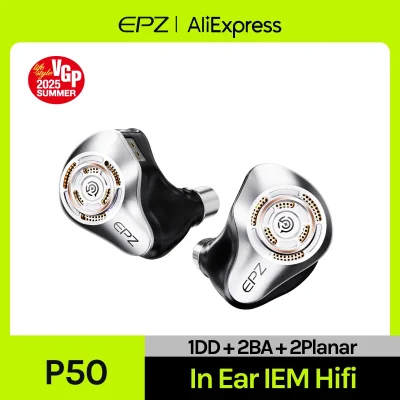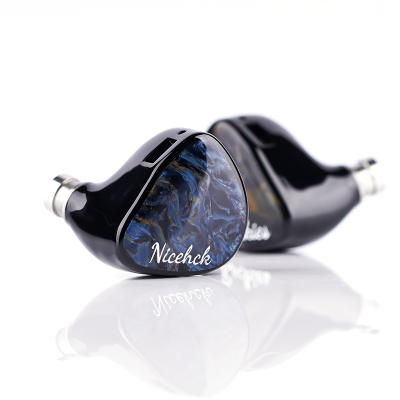EPZ P50 and Nicehck Rockies use 1DD+2BA+2Planar and 1DD+2BA+2EST driver setups respectively. EPZ P50 costs $205 while Nicehck Rockies costs $499. Nicehck Rockies is $294 more expensive. Nicehck Rockies holds a clear 0.8-point edge in reviewer scores (7.2 vs 8). User ratings place EPZ P50 at 9.5 and Nicehck Rockies at 9. Nicehck Rockies has better bass with a 0.8-point edge, Nicehck Rockies has better mids with a 0.8-point edge, Nicehck Rockies has better treble with a 0.7-point edge, Nicehck Rockies has significantly better dynamics with a 1.1-point edge, Nicehck Rockies has better soundstage with a 0.8-point edge, Nicehck Rockies has better details with a 0.5-point edge and Nicehck Rockies has better imaging with a 0.6-point edge.
Insights
| Metric | EPZ P50 | Nicehck Rockies |
|---|---|---|
| Bass | 7.6 | 8.4 |
| Mids | 7.9 | 8.7 |
| Treble | 7.4 | 8.1 |
| Details | 7.6 | 8.1 |
| Soundstage | 7.3 | 8.1 |
| Imaging | 7.7 | 8.3 |
| Dynamics | 6.5 | 7.6 |
| Tonality | 7.2 | 8.5 |
| Technicalities | 7.2 | 8.5 |
EPZ P50 Aggregated Review Score
Average Reviewer Scores
Average Reviewer Score:
7.2Generally Favorable
Nicehck Rockies Aggregated Review Score
Average Reviewer Scores
Average Reviewer Score:
8Strongly Favorable
Reviews Comparison
EPZ P50 reviewed by Super* Review
Youtube Video Summary
EPZ’s P50 feels like a breakout for the brand: a compact, medium-small shell with a vented faceplate that’s marketed as “open-back,” yet isolates like a typical IEM. The unboxing is tidy at this price—carry puck, a real microfiber cloth, and two sets of generic tips—while the modular cable (screw-lock swappable termination) is handy if a bit thin, stiff, and kink-prone; the 2-pin plug sits slightly proud of the socket and the “R” marking is visible on the outside. The long nozzle (~5.5 mm diameter) can push fit depth, so shorter tips (e.g., NF Audio-style) help; once set, stability and comfort are excellent. Overall build looks clean and modern, if a touch editorial compared with EPZ’s other shells.
Sonically, P50 embraces the current tilted diffuse-field “new meta” with a mostly neutral, natural presentation and a later-rising, sub-bass-centric lift that gives bounce rather than mid-bass thump. There’s a hint of extra presence around the 4–5 kHz region that adds macro-contrast—vocals pop with definition and separation is crisp—while upper treble stays safe: cymbals are clean but a bit light in weight. Bass is tight and incisive rather than slammy; micro-texture on vocals is good, though the set favors that big, “stagey” contrast over ultra-fine grain. It’s easily EPZ’s best tuning so far: clear, organized, and engaging without drifting from neutral-ish aims.
Against peers, Kiwi Ears K4 tracks a similar target but sounds lower-contrast and can blur on dense mixes; P50 hits harder on transients, images more cleanly, and keeps busy tracks sorted, while K4 offers a richer midrange with “frothier” treble. Versus the Binary Chopin, Chopin is warmer, fuller, and more mid-bass driven—more “analog” and atmospheric—with deeper perceived space but a bulkier fit; P50 is leaner, clearer, and the least bass-forward of the three. Verdict: a confident 4/5 for delivering a small, comfy fit and a clean, contrasty neutral that competes squarely around $200–$250. If the brief is “neutral with a bit of drama,” this is a strong pick—and a promising sign of where EPZ can go next.
Super* Review original ranking
Super* Review Youtube ChannelBuy EPZ P50 on Aliexpress
Ad
Price: $199
Buy EPZ P50 on Aliexpress
Nicehck Rockies reviewed by Super* Review
Youtube Video Summary
NiceHCK Rockies lands as a $500 tribrid (1DD+2BA+2EST) that mirrors the Mega5-EST’s tuning with subtle tweaks. The unboxing is generous—three styles of tips (including AET07-style and tacky “medical” silicone), a large puck case, and a swappable 3.5/4.4 screw-lock plug. Build feels premium with a real pietersite stone faceplate; fit is comfortable but shell geometry is generic, so stability depends on tips. The stock cable looks nice but is stiff and, notably, has no chin slider.
Sonically, Rockies follows a tilted diffuse-field / “new meta” balance with slightly less bass and a touch more lower-treble than Mega5-EST—on the order of ~1 dB each way. That shift tightens the low end and improves separation/imaging, making the set feel more technical; however, it also trims warmth and depth, leaving the presentation a bit dry/brittle at times. Bass quality is clean and controlled rather than showy; treble reads clear without obvious harshness on the 711 rig readout, though it can edge lean.
Against peers, Mega5-EST stays the easier, warmer listen with slightly “thuddier” bass, while DUNU’s Brain Dance is the pick for maximum excitement and staging (more clinical up top). Moondrop x Crinacle Dusk (analog use) offers stronger imaging and notably satisfying bass execution at a lower price. Rockies ends up a very good, balanced all-rounder that some will prefer over Mega5-EST for its tidier bass and clarity, but the trade for brightness and dryness is real—final verdict: 3/5.
Super* Review original ranking
Super* Review Youtube ChannelBuy Nicehck Rockies on NiceHCK
Ad
Price: $499
Buy Nicehck Rockies on NiceHCK
EPZ P50 reviewed by Tim Tuned
Tim Tuned Youtube Channel
Nicehck Rockies reviewed by Tim Tuned
Tim Tuned Youtube Channel
EPZ P50 reviewed by Jaytiss
Jaytiss Youtube Channel
Nicehck Rockies reviewed by Jaytiss
Youtube Video Summary
NiceHCK Rockies lands in the ~$500 bracket with a 1DD+2BA+2EST setup and a surprisingly premium package. The hollow resin shell feels solid, with a metal nozzle, slightly recessed 2-pin, good isolation, and comfy fit. The swappable-termination cable is thick, pliant, and lays flat—no chin slider out of the box, but easy to add—and the excellent case and tip kit push the accessories into “above class” territory.
Tonally, Rockies goes for tight, controlled bass and a natural midrange, capped by upper-treble that’s sparkly yet refined—detailed without getting shouty or brittle. The graph reads largely flat with a tasteful treble lift, translating to a clean, clear presentation that stays engaging rather than fatiguing. It comes across as an “instant classic” tuning: lively, airy, but still grounded.
Compared with brand siblings (DB2 too upper-midsy; F1 Pro/NX8 fine but not special), Rockies feels like the step up. Versus peers, it splits the difference: more air and delicacy than RSV MK2 (which is bassier/darker), less sizzle than sets that chase treble for effect, and broadly similar endgame vibes to “good” units of Mega5-EST—variance there being the rub. Net: a high-value pick at its price, worthy of a Gold Star—not a universal “benchmark,” but a sweet, natural, clear listen that many will prefer, especially with the standout accessories.
Jaytiss Youtube Channel
EPZ P50 reviewed by Jays Audio
Youtube Video Summary
The EPZ P50 comes in hot as a new tribrid and a potential $200 neutral benchmark, trading sterile restraint for a more vocal-centric presentation. Versus the MEGA5EST, vocals sit a touch more forward—adding emotional weight and clarity—while the MEGA5EST still edges it on sheer smoothness and EST “air.” Compared to Meteor, the P50 fills in the lower mids, dials back 1–3 kHz glare, and opens the top end a bit; Meteor stays a hair softer up top. The catch is bass: the P50’s DD is competent but not a sub-bass shaker—expect clean rather than authoritative slam.
Against peers, the P50 sounds fuller and more natural than Supermix 4 (which is brighter and more “hi-fi” energetic), and it trades blows with Odyssey: Odyssey brings better bass texture and treble micro-detail, while the P50 delivers superior vocal clarity and a touch more air. It excels at mid-volume listening—Volume S needs more gain to bloom—and outclasses lighter, air-tilted sets like “K4” style tunings when male vocals or body are the priority. Accessory game is strong too: a nicer cable and a genuinely sturdy hard-leather case sweeten the deal. Not the most “unique” flavor and not for bassheads, but as a balanced, clean, vocal-forward option around $200, P50 is an easy recommendation for those chasing neutrality without the vanilla.
Jays Audio Youtube Channel
Nicehck Rockies reviewed by Jays Audio
Youtube Video Summary
The NiceHCK Rockies have a balanced tuning with standout treble extension from its ESTs. Vocals are tamer with a cut in the upper mids, trading sparkle-forward presence for a smoother, airier presentation; staging feels more open because bass and vocals sit slightly back, while cymbal decay lingers with a pleasing airiness. Technical performance is very good for the price—punching above many $500–$600 peers—and the unboxing/accessories package adds to the overall value.
Low end is grounded and tidy rather than slammy; texture and separation are solid, but this isn’t for bassheads or those wanting vocal-forward excitement (sets like Top Pro or Volare cover that better). The Rockies excel with rock/metal/indie/classical where the extra air, layering, and controlled upper energy shine; they scale best at mid volumes, and tip rolling should avoid options that over-boost or dull the treble—the stock tips already hit a sweet spot. Net: a confident recommendation at ~$500–$600 for listeners prioritizing treble quality, detail, and spaciousness, with the main trade-off being a more restrained bass and laid-back vocal emphasis.
Jays Audio Youtube Channel
EPZ P50 reviewed by Head-Fi.org
Nicehck Rockies reviewed by Head-Fi.org
EPZ P50 reviewed by Web Search
The EPZ P50 is a tribrid with a 10 mm dynamic driver, two balanced armatures, and two micro planar drivers, implemented in a semi-open back shell and a three-way crossover—an uncommon configuration at this price tier. Listings and spec sheets place impedance at 20 Ω and sensitivity around 106 dB, with interchangeable 3.5/4.4 mm plugs and 0.78 mm 2-pin connectors, positioning it as a flexible daily-carry IEM near the $200 mark.
Subjectively, multiple reviews converge on a neutral-with-bass-boost presentation: sub-bass is tight and weighty when called for, mids stay clear and slightly forward, and treble is extended with extra energy from the planar tweeters. This yields a clean center image and articulate vocals without obvious mid-bass bloom, though the upper-treble emphasis can read “sharper” on some recordings.
Technical performance is competitive for the class: reviewers note solid imaging, above-average separation, and a stage that feels wider than typical sealed IEMs—qualities plausibly aided by the semi-open design and multi-way damping. Trade-offs include reduced isolation versus closed shells and a treble tilt that may fatigue treble-sensitive listeners at high volumes, but overall resolution and micro-detail retrieval punch above its price.
Nicehck Rockies reviewed by Web Search
The NiceHCK Rockies is a five-driver tribrid using 1DD + 2 Knowles BA + 2 Sonion EST in a resin shell with Pietersite stone faceplates. Specs list a detachable 0.78 mm 2-pin cable with swappable 3.5/4.4 mm plug, 9.8 Ω impedance and 121 dB/Vrms sensitivity, indicating easy driveability from portable sources.
Early third-party coverage characterizes the tuning as neutral with a sub-bass lift and smooth, controlled treble, with 5128 measurements available via Crinacle’s public database and a review on Hangout’s channel. These impressions emphasize strong imaging and detail without obvious harshness when recordings are clean.
At an MSRP of $499 (with a short launch price of $469), value hinges on preference for an energetic, U/neutral-with-bass presentation; listeners sensitive to upper energy may find mids a touch lean on certain material, as some impressions note. In short, Rockies trades a warm mid focus for sub-bass reach, treble resolution, and a stable stage that suits modern pop, electronic, and large-scale orchestral.
EPZ P50 (more reviews)
EPZ P50 reviewed by Audio Amigo
Youtube Video Summary
EPZ P50 comes as a tribrid at $185 with a surprisingly complete kit: a sturdy leatherette case, modular 3.5/4.4mm terminations, three silicone tip sets, and a cleaning cloth. The resin shells are semi-custom with aluminum faceplates; comfort is generally good but anatomy-dependent, and the stock cable—while well finished—runs on the stiff side. A standout twist is the factory customization option (~$225 total for the “Grindphones” style), which notably doesn’t alter the tuning in any meaningful way. The set is easy to drive, shows minimal change with impedance adapters (a touch warmer/more vocal-forward), and avoids pressure issues thanks to smart internal venting.
Sonically, tuning sits as a controlled, mild V: bass is just north of neutral with pleasing texture and impact, mids stay clean with an engaging female-vocal emphasis, and treble adds airy sparkle without turning tizzy—though insertion depth can trigger length-mode variability for some ears. Technical chops impress at the price: detail retrieval punches up, imaging is precise with good separation, and stage reads average but coherent. Against peers, P50 feels more resolving than Kiwi Ears K4 (trades bigger bass/sparkle for better mid clarity), brighter and more vocal-present than the neutral-leaning Ziigaat Lush, and echoes a Dunu Da Vinci vibe with less bass. Verdict: tremendous value and a terrific pick for vocal-centric libraries—highly recommended to audition first if treble sensitivity or fit quirks are a concern.
Audio Amigo Youtube Channel
EPZ P50 reviewed by Kois Archive
Youtube Video Summary
The EPZ P50 arrives as a ~$200 tribrid with a slick presentation: FR graph on the box, a puck-style case, plenty of tips (oddly two identical sets), and a nice microfiber cloth. Build leans premium with a semi-open back and a faceplate that gives “arc reactor” vibes. The custom shell offers a secure fit for most, though very small ears—or anyone sensitive to an inner wing—may need caution. The modular cable (3.5/4.4 mm) is practical yet slightly stiff and retains some memory; isolation is typical of sealed IEMs despite the semi-open styling.
Sonically, the P50 goes for a warm-balanced tuning. Bass quality impresses: bouncy with deep sub-bass reach, prioritizing texture and control over sheer quantity (more thump is possible via an impedance adapter). Mids read natural with a touch of warmth—male vocals shine—while female vocals can feel a bit lean due to a more relaxed upper-mid energy. Treble is smooth, inoffensive, and “planar-clean” without planar timbre, with only a slight wish for more top-end extension.
Technical performance is the star. The micro planars pull out micro-detail unusually well for the price; imaging, separation, and overall resolution feel confidently executed, making guitars pop and busy mixes easy to parse. That clarity translates to gaming, where positional cues and crowded soundscapes (think battle royale chaos) remain intelligible—worthy of a two-controller gaming nod. Overall, the EPZ P50 is a solid contender at this price: balanced tuning with standout detail retrieval and imaging, tempered only by mids that play it a little safe. For listeners unbothered by a gentler upper-mid lift, it’s well worth the money—a two-star recommendation.
Kois Archive Youtube Channel
EPZ P50 reviewed by Paul Wasabii
Youtube Video Summary
The EPZ P50 is a five-driver open-back hybrid (1DD + 2BA + 2 micro-planars) that arrives with a solid accessory kit and a sensible price. The tuning is the highlight: a vocal-centric balance that avoids the over-energetic tilt of some Harman-leaning sets, while keeping a clean background and strong clarity. Sub-bass is trimmed for control, mid-bass adds body, and the result is natural male vocals and a presentation that feels both transparent and organized.
Upper mids rise earlier for familiar presence, and treble is extended by the micro-planars yet kept in check for wider appeal than brighter peers. Resolution is high for the class and the set can be revealing, sometimes asking for a touch more volume and occasionally sounding a bit unforgiving on hot masters. Bass is snappy rather than booming, trading rumble for speed and definition to keep the midrange clean.
Stage and imaging are standouts: spacious, precise, and helped by bass control and the open shell design. Compared with typical u-shaped ~$200 hybrids, this tuning prioritizes mids and coherence, showcasing a clear, extended top without brittleness. As a sub-$100 tribrid, the P50 delivers impressive value and feels like a sign of what is to come in this segment.
Paul Wasabii Youtube Channel
EPZ P50 reviewed by Gizaudio Axel
Nicehck Rockies (more reviews)
Nicehck Rockies reviewed by Fox Told Me So
Tonally, Rockies follows JM1’s safe neutral-ish slope but with leaner mids and brighter treble. Bass is punchy, quick, and well-controlled; mids a touch dark but cleanly separated; and treble opens into airy, effortless EST sparkle with no sharp edges. Stage has decent depth over width, resolution solid for the price, immersive enough without grandeur.
Verdict: not flawless (could use more sub-bass reach, meatier bass, thicker mids, and wider stage), but well-executed overall. A satisfying, balanced tribrid that showcases EST treble gracefully without breaking the bank.
Fox Told Me So original ranking
Fox Told Me So Youtube ChannelNicehck Rockies reviewed by Audionotions
EPZ P50 Details
Driver Configuration: 1DD+2BA+2Planar
Tuning Type: Neutral with Bass Boost
Price (Msrp): $205
Support our free service! Buying through our affiliate links costs you nothing extra:
Nicehck Rockies Details
Driver Configuration: 1DD+2BA+2EST
Tuning Type: Neutral with Bass Boost
Brand: NiceHCK Top NiceHCK IEMs
Price (Msrp): $499
Support our free service! Buying through our affiliate links costs you nothing extra:
EPZ P50 User Review Score
Average User Scores
Average User Score:
Based on 1 user reviews
9.5Exceptional
Nicehck Rockies User Review Score
Average User Scores
Average User Score:
Based on 2 user reviews
9Outstanding
EPZ P50 Gaming Score

Gaming Score & Grade
- The gaming score is prioritizing technical capabilities of the IEM (Separation, Layering, Soundstage) and good value.
Gaming Score
7.2Gaming Grade
A-Nicehck Rockies Gaming Score

Gaming Score & Grade
- The gaming score is prioritizing technical capabilities of the IEM (Separation, Layering, Soundstage) and good value.
Gaming Score
8.2Gaming Grade
A+EPZ P50 Scorings
Average Technical & Tuning Grades
Average Tunign Grade
A-- The tonal character feels settled and versatile, with just a few gentle bumps. You can listen for hours without fatigue.
Average Technical Grade
A-- You get a controlled, composed performance, marrying decent clarity with a still-modest sense of space. A safe technical performer for the price bracket.
Nicehck Rockies Scorings
Average Technical & Tuning Grades
Average Tunign Grade
S-- A masterfully balanced signature renders music effortlessly realistic and emotionally engaging. Nuanced mixes benefit from its balance.
Average Technical Grade
S-- A very capable technical display delivers articulate layers and poised imaging. It portrays reverbs and echoes with confidence.
EPZ P50 User Reviews
Share your experience and build your personal ranking list.
You need to be signed in to write your own reviewKillabuck.
Pros
No roughness, Natural timbre, Balanced signature, good note density, Very good consistency, comfortable to use, Good cable, Technically amazing, good accessories, good tips, good transparency, good brightness, tactile bass, not much warmth, nice voices.Cons
None.Nicehck Rockies User Reviews
Share your experience and build your personal ranking list.
You need to be signed in to write your own reviewA lively rendition of the diffuse field tuning that tilts slightly upward for additional clarity. Tastefully bass-boosted DD, clear and clean BA mids with slightly recessed vocals, and standout EST treble presence make an engaging JM-1 all-rounder.
Pros
Lively, unique take on neutral with bass boost. Excellent detail.Cons
An ever so slight increase in bass shelf could provide more dynamicism.Lively tribrid with engaging low end and airy detail that still sounds cohesive. Strong technical performance for the price without losing musicality.
Pros
Punchy, fast bass with good texture and sub-bass reach. Smooth-leaning EST treble with high detail and precise imaging; comfortable fit and solid isolation.Cons
V-shaped balance leaves mids a bit recessed. Treble can lean bright on poor recordings.Find your next IEM:
IEM Finder Quiz
newIEM Comparison Tool
newVS


























